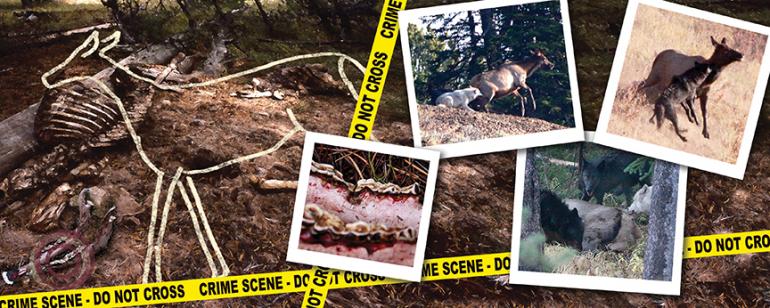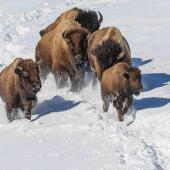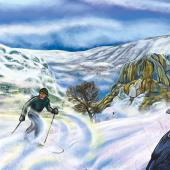Yellowstone CSI
Canyon wolf pack edition.
Driving down from Dunraven Pass in Yellowstone Park, we spotted four wolves on the road, coming our way. It was the Canyon pack: the alpha pair and two others. They left the road and moved uphill, disappearing among the trees. Guessing that they might parallel the road in our direction, we pulled the car over to wait and watch. My four passengers and I were giddy in anticipation of the scene that was soon to unfold before us.
The Crime
Within a few minutes, the alpha female and a smaller black wolf—her one-and-a-half-year-old daughter—emerged from the treeline not far from our position, pursuing a cow elk. The elk paused among some rocks to stage a defense, but the alpha, a beautiful white wolf, began to work around the elk’s legs. The elk made a fleeting run down the hill with the two wolves in hot pursuit. Each step brought them closer to us; it was surreal and happening fast.
The black wolf leapt in the air and latched on to the throat of the elk in hopes of collapsing the windpipe. She was winging around in front of the elk, on the downhill side, with all four of her legs off the ground. This wasn’t the best spot, should the 500-pound elk trip and fall, but she was young and headstrong.
The daughter tumbled into the ditch near the roadside, seemingly trampled by the running elk, yet was up and immediately back in the chase. The alpha redoubled her own efforts as they went lickity-split across the road. Once the elk reached treeline, no more than 60 yards behind our vehicle, she gave us one last fleeting look. It was only a matter of seconds before she was down, with the black wolf latched onto her throat once again. From start to finish, the chase and take-down took only a few minutes.
The Investigation
Exactly one week later, we decided to do a little Yellowstone CSI (Carcass Scene Investigation). There can be an amazing amount of clues left at the scene from a wolf kill to help determine why a particular animal was singled out. We wanted to know more and so we took a closer look.
When looking at a carcass site from a biological perspective, one of the many pieces of the puzzle is the prey’s age. First, find the lower jaw and look at the wear of the molars. This cow elk’s molars were worn down to almost to the gum line. We also noticed some abnormalities with the lower left molars, which was the clue we were looking for: she had an abscessed tooth. The bone was deformed and grasses were jammed between the teeth.
It just so happened that one of our group was a dental hygienist who knows a thing or two about teeth. So here is how our thought process went. This cow, probably over 14 years old, was obviously suffering from an abscessed tooth. If the cow suffered from a periodontal abscess in the soft tissue, it may have been caused by packing grasses between the tooth and gum, or possible injury. If it was an apical abscess, caused by bacteria inside the pulp chamber of the tooth, this would have caused swelling. The swelling would cause pain and make eating difficult, which in turn would lead to malnourishment and a sickly appearance. If the elk had a fistula (an abnormal passage allowing discharge of inflammatory material), there would likely be a rank smell coming from her mouth—but she would have experienced less pain, which would allow her to graze and feed easier. Looking back to the actual kill, from an outward appearance she seemed pretty healthy. And as the wolves opened her up for their morning meal, we’d noticed that her rumen was full of grass and she had a noticeable fat layer around her mid- and rump section.
So it seems that the wolves were walking through the forest just west of the roadway and slightly south of Dunraven Picnic Area when they came across a group of elk. A foul odor permeated the air and the alpha female clued into it. She took a step toward the elk with the others in her pack to test the group and pinpoint the stench’s source. The cow in question made a run for it, dashing out of the woods to an open rocky area. She stood her ground, kicking backward and forward, hoping to thwart her aggressive attackers. With this tactic not working, she made a last-ditch run downhill toward the roadway and humans. The rest of the story is, well... history.
Wolves are clearly selective hunters. This elk might have looked healthy from the human eye, but the wolf held a greater knowledge through its acute sense of smell. We have now concluded this edition of the Yellowstone Carcass Scene Investigation.
MacNeil Lyons is a naturalist, guide, and photographer based in Gardiner. See his work at macneillyonsimages.com.













